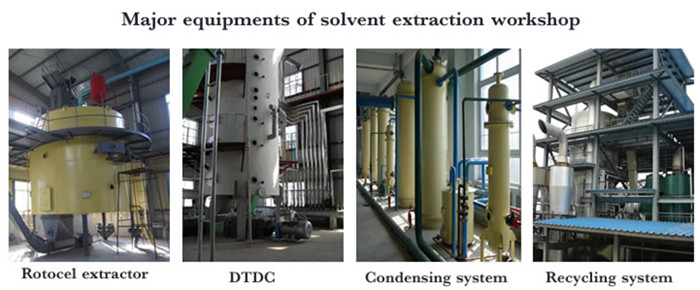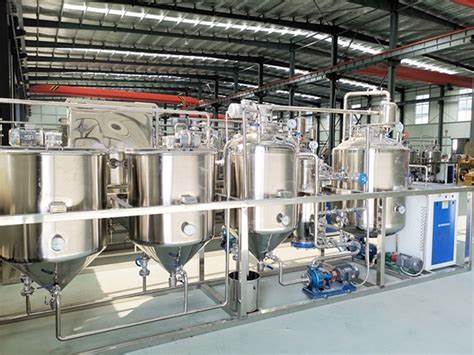Because of its high extraction rate, the leaching process plays a relatively large advantage in the modern edible oil processing industry, but there are always people who question the harmfulness of solvent residues. As a commonly used edible oil extraction process, the country will formulate corresponding testing standards to control the quality of refined oil. Therefore, the country has strict testing standards for the solvent residues of edible oil in the extraction process, and the solvent residues in each kilogram of edible oil ≤20mg.

1. What is the solvent used in the leaching process?
The solvent used in the edible oil extraction process is n-hexane, commonly known as No. 5 gasoline, which is an organic solvent. It can dissolve oil very well, so that the oil can be extracted from the oil. In the leaching process, the solvent can be recycled. After evaporation, it is recovered by condensation and stored in the solvent turnover tank for next use.
2. How does the leaching process extract edible oil?
The entire edible oil leaching process is divided into 4 parts: oil leaching section-wet meal desolventizing section-mixed oil evaporation section-solvent recovery section
(1) Oil extraction section: The pre-processed oil (soybean/rice bran) or pre-pressed cake (peanut/rapeseed, etc.) is sent into the extractor, after spraying the required amount of solvent, after a period of reaction, The grease in the oil will be fully dissolved in the solvent, and then two parts of the product will be obtained: wet meal and mixed oil.
(2) Wet meal desolventization section: The wet meal obtained from the oil leaching section generally contains 25%-35% solvent. In order to recover the solvent, the wet meal needs to be sent to the steaming machine to use solvents and grease. The evaporation point is different, the solvent is evaporated into vapor and removed from the wet meal, and then the wet meal without solvent is dried to obtain dry meal. Dry meal can be processed into animal feed and sold on the market, and the solvent that becomes vapor will enter the solvent recovery system for solvent recovery.
(3) Mixed oil evaporation section: This section is mainly used to remove residual solvent in crude oil. The mixed oil evaporation system mainly uses evaporation and stripping processes to achieve the purpose of desolventization. The main equipment used in this section is: d long Tube evaporator, second long tube evaporator and stripper. After passing through the d long tube evaporator, the concentration of the mixed oil is about 70%. After passing through the second long tube evaporator, the concentration of the mixed oil is 90-95%. After passing through the stripper, the concentration of the mixed oil can reach almost 100. %. After this section, we will get two parts of products, crude oil and vapor solvent. Crude oil can be transported to the refining workshop for further processing, and the vapor solvent will be transported to the solvent recovery section where it is condensed and recycled.
(4) Solvent recovery section: The vapor solvent separated in either the wet meal desolventization section or the mixed oil treatment section will be cooled into a liquid solvent for recycling in this section.

3. How to ensure that the edible oil solvent residues in the leaching process meet the standards?
Although there is only a trace amount of solvent residues in the crude oil obtained by the leaching process, it still does not meet the national standard for direct consumption. Therefore, the leached oil needs to be refined by edible oil refining equipment (additional link jump) can be refined before it can be eaten with confidence.
Regarding the quality of edible oil products, the state has formulated a series of indicators, called national standards. All types of grease have corresponding standards, generally including "color", "odor", "transparency", "soap content", "insoluble impurities", "acid value", "peroxide value" and "solvent residue" "Quantity" and other items. Among them, "acid value", "peroxide value" and "solvent residue" are mandatory indicators. According to national standards, all products that meet the standards are edible oil products.
In addition, the leaching method for preparing oil is currently an internationally recognized excellent production technology, and the leaching method was initially applied and developed in developed countries. In recent years, leaching oil production technology has also been widely used in my country's oil production. Under normal circumstances, the leaching oil production process is more suitable for processing the extraction of oil from crops with low oil content. It can make the residual oil ratio in the cake less than 1%. In addition, it also has the characteristics of high economic efficiency and low processing cost.

In general, both the squeezing oil production method and the leaching oil production method are relatively popular oil production processes. If you have plans to develop edible oil processing business, it is recommended that you directly contact the Zhongxing oil and fat equipment manufacturer. Our engineers will customize a suitable project solution for you according to your specific needs and provide a suitable edible oil processing technology.
Copyright © Henan Zhongxing Grain And Oil Machinery Co.,Ltd. All Rights Reserved. Powered by MetInfo